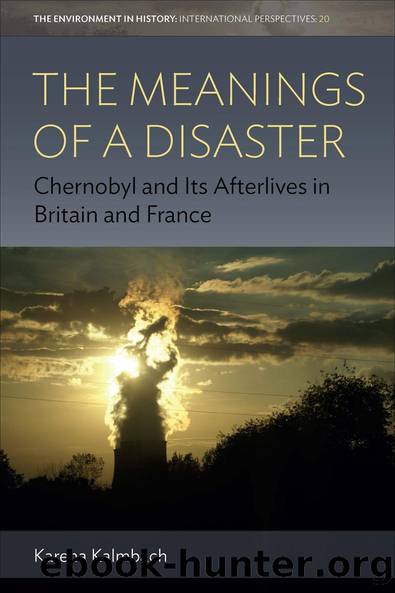The Meanings of a Disaster by Karena Kalmbach

Author:Karena Kalmbach [Kalmbach, Karena]
Language: eng
Format: epub
Tags: History, Europe, General, Political Science, Public Policy, Science & Technology Policy, Technology & Engineering, Power Resources, Nuclear
ISBN: 9781789207033
Google: XSDcDwAAQBAJ
Publisher: Berghahn Books
Published: 2020-12-07T22:16:26+00:00
Critical Voices
The GSIEN activists had been among the first to contest the official French statements on Chernobylâs impact in 1986, in particular Bella and Roger Belbéoch. In the 1980s, the Belbéochs were among the best known and most publicly visible French anti-nuclear activists and also co-founders of the Comité Stop Nogent in 1987. In May 1986, Bella Belbéoch wrote an article for Ecologie, the Société française dâécologie magazine. Her predictions for the trajectory of the official Chernobyl evaluations became a reference point for critical voices in the French Chernobyl debate. On 1 May 1986, she wrote:
In the coming days, we can expect an international complot of official experts who will try to minimize to the maximum the number of victims of this catastrophe. The continuance of the civil and military nuclear programmes imposes on the collectivity of states a tactical complicity that exceeds ideological or economic conflicts. The international health organizations, which are in principle independent from the states but strictly controlled by the Great Powers, will serve as liaison agencies to uphold the appearance of objectivity and neutrality.112
Because of their concerns, Bella and Roger Belbéoch continued to closely follow the work and reports of the international committees and expert groups put in charge of evaluating Chernobylâs impact in the most affected regions of Eastern Europe. They scrutinized the publications released by the WHO and the IAEA. In 1992, in their contribution to the first edition of the journal LâIntranquille, they addressed the wider public, strongly criticizing the official narrative diffused internationally about Chernobylâs impact.113 The following year, a revised and expanded version of this article was published as a book.114 In it, the Belbéochs discussed various aspects of the Chernobyl issue: the contemporary situation in the most affected regions, the struggle to define the dose limit for evacuation, the changing estimates of the number of victims, the alienation strategies applied in the West and so on. A key aspect of their argument was contesting the radiophobia concept that featured prominently in the Soviet and international expert groupsâ evaluation. In the chapter âLe complot internationalâ (the international conspiracy) the authors incorporated all the aspects on Chernobyl they had presented into one claim: âThere is nothing surprising about what is happening at the moment within the circle of expertsâ.115 As Bella Belbéoch had predicted in her article for Ecologie in 1986, all Chernobyl-related activities and communications were aimed at protecting the international civil and military enterprise from being profoundly questioned:
The complicity of the Western experts, scientists, technicians, doctors, sociologists and specialists in humanitarian aid was, without reservations, aimed at helping the central powers to âmanageâ the social, economic, and political crisis that had emerged as a consequence of the accident. It was necessary to convince the people living in the contaminated areas that they had nothing to fear about their health. Those who were sent to âliquidateâ the consequences of the catastrophe at the site itself were not to question the doses of radiation they received or would receive. The rapid
Download
This site does not store any files on its server. We only index and link to content provided by other sites. Please contact the content providers to delete copyright contents if any and email us, we'll remove relevant links or contents immediately.
Whiskies Galore by Ian Buxton(41725)
Introduction to Aircraft Design (Cambridge Aerospace Series) by John P. Fielding(33022)
Small Unmanned Fixed-wing Aircraft Design by Andrew J. Keane Andras Sobester James P. Scanlan & András Sóbester & James P. Scanlan(32690)
Craft Beer for the Homebrewer by Michael Agnew(18087)
Turbulence by E. J. Noyes(7901)
The Complete Stick Figure Physics Tutorials by Allen Sarah(7273)
Kaplan MCAT General Chemistry Review by Kaplan(6829)
The Thirst by Nesbo Jo(6769)
Bad Blood by John Carreyrou(6483)
Modelling of Convective Heat and Mass Transfer in Rotating Flows by Igor V. Shevchuk(6359)
Learning SQL by Alan Beaulieu(6166)
Weapons of Math Destruction by Cathy O'Neil(6090)
Man-made Catastrophes and Risk Information Concealment by Dmitry Chernov & Didier Sornette(5883)
Digital Minimalism by Cal Newport;(5593)
Life 3.0: Being Human in the Age of Artificial Intelligence by Tegmark Max(5410)
iGen by Jean M. Twenge(5333)
Secrets of Antigravity Propulsion: Tesla, UFOs, and Classified Aerospace Technology by Ph.D. Paul A. Laviolette(5244)
Design of Trajectory Optimization Approach for Space Maneuver Vehicle Skip Entry Problems by Runqi Chai & Al Savvaris & Antonios Tsourdos & Senchun Chai(4962)
Electronic Devices & Circuits by Jacob Millman & Christos C. Halkias(4871)
